6 Poisonous Flowers That People Grow for Some Ridiculous Reason
Author: Jen Worst | Editor: Omar Alonso
Review & Research: Jen Worst & Chris Miller
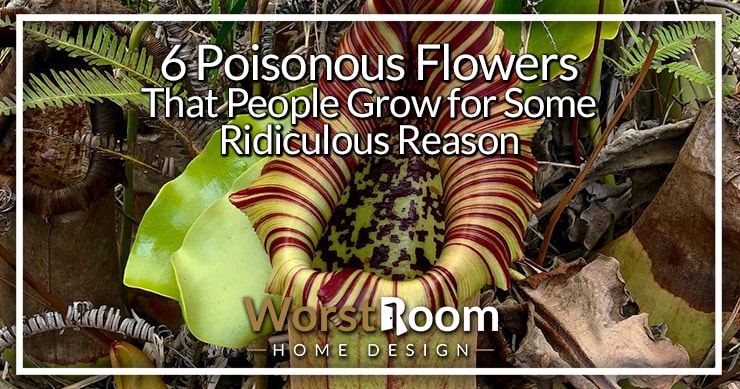
Growing poisonous flowers is getting increasingly popular in backyards and flower beds these days. People are always looking for options that are not only visually captivating but also easy to grow.
We all want our garden to look mesmerizing. This is why we plant flowers that can grow fast and add vibrant colors to our place. There's only one problem...
These flowers are harmful and even deadly to human beings. Although they're very attractive, they can be a risk for you, your children, or your pets. These toxic flowers contain known poisonous chemical compounds.
This is why you should never give a sniff or touch a flower while you’re out on a camping trip or a similar adventure unless you can identify them first.
They produce such substances to protect themselves from the predators, and that includes us. Like humans, plants have also modified themselves for their survival.
Some knowledge of these toxic flowers can save you from growing the wrong flowers at your home or picking the wrong ones on your day trips. Each of these deadly flowers have different harmful effects.
Sometimes, you can even find these flowers at your local nursery with other common species. Due to this, you should keep your kids and pets at bay for their safety.
Furthermore, avoid ingesting the flowers that are not known to you. Poisonous flowers to humans may appear like a regular flower with different colors and mesmerizing patterns.
6 Poisonous Flowers
If you’re going out on an adventure or plant flowers in your lawn, here is a list of poisonous flowers that you need to avoid.
Nerium Oleander
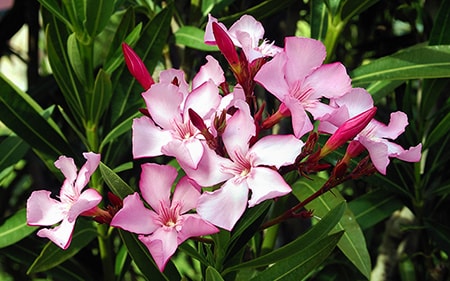
This plant is famous for having a sweet scent. They are large and can grow to be over 6.5 to 19.5 inches in height. This type of poisonous plant thrives in late spring to summer.
Generally, this plant has a bunch of white, pink, purple, and magenta flowers at the ends of its branches. They grow in subtropical regions of the world.
They're mainly found in Asian countries. They're infamous because many people have used this plant to take their lives.
Every part of this plant is toxic. The chemical compounds of this plant directly affect the cardiac muscles. Growing these are simply not worth the risk.
If someone ingests this plant, the person may face symptoms like drooling, nausea, and seizures. You should never burn this plant. Inhaling the smoke may cause some severe health problems.
According to research, the honey that is made by the nectar of this flower is also poisonous. If you must, handle them with gloves. Or you could, like, have a bee farm and learn how to store honey that you can safely enjoy.
Aconitum
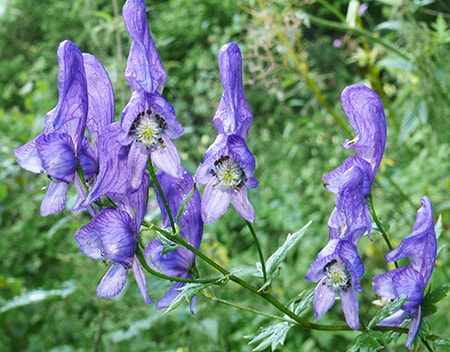
These poisonous flowers are widely known because of their uses in traditional medicine. The roots of this flower are essential for some medicinal purposes due to its toxicity.
They have a few other amusing names, such as wolf’s bane, devil’s helmet, blue rocket, monkshood, etc. It is one of the most toxic flowers that is found in Western Europe.
They have a very bright purple color. Their petals are curved downwards, which makes them look like a helmet. This is the reason why they are named as the devil’s helmet.
These flowers belong to the buttercup family. Also, they have hundreds of different species, but thankfully they're easily identifiable by their appearance.
Centuries ago, these flowers were used in different kinds of potions. They may cause dizziness, numbness, and heart palpitations.
In most cases, they ended up taking the lives of those who consumed it. This is the main reason why the name mourning widow was given to them.
Castor Oil Plant
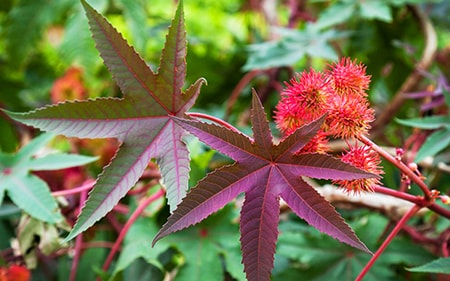
As we all know, castor oil is used for healing or at least comforting various illnesses. Over the years, it's been frequently used in Chinese medicine to repair wounds.
It's also used in a number of industries to serve different purposes. In recent times, people are also using it as a biofuel. However, the plant which produces it is the most poisonous in the world.
The flower of this plant closely resembles a spikey red or dark pink ball. Hence, you must keep the children away from them.
Even though they look very interesting, you must never touch them with bare hands. The seed of this plant secretes a compound called ricin. Ricin is extremely dangerous and can kill a person in a few minutes.
The leaves of this plant also contain ricin in small amounts. Most of the time, the leaves are either dark green or burgundy in color. This plant is also called the palm of Christ.
Dracunculus Vulgaris
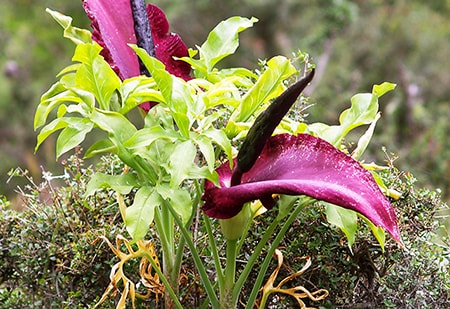
This is also referred to as Dracula’s flower. These flowers produce a very unpleasing odor. Its flowers reek of rotten meat after maturation. As a result, they attract flies and insects.
These flowers feed on these insects and use its pungent odor and color as bait. The flowers are maroon, or purple with a long, black pistil that looks like a pointy tongue.
These plants can grow not more than 40 to 50 inches tall. Mostly, these poisonous flowers bloom in late spring. Moreover, they don't need much sunlight to grow. The entire plant is toxic. If you come in contact with these, you may experience skin irritation or allergy.
Abrus Precatorius
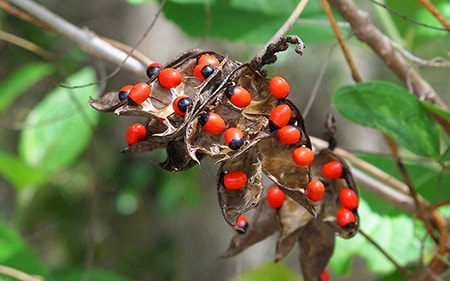
Hundreds of years ago, the seeds of these plants were used to make jewelry. Many people have died while making jewelry from them. They also produce a toxin which is called abrin. Also, they are often called by the name Jequirity.
Furthermore, they're utilized in medicines to treat many ailments like asthma, constipation, liver disease, infections, etc. These plants belong to the pea family.
The leaves of these plants are long and contain scarlet beads. These plants are mainly originated in Southeast Asia and Australia. They need that tropical and subtropical environment to grow.
Despite their toxicity, these plants are very attractive. This is why they are also used as ornamental plants.
If a person consumes only a single bead of this flower, it may cause severe damage. Symptoms of poisoning from this flower may include vomiting, seizures, liver failure. If the person is not treated, the poison may cause the person to expire in a few days.
Nepenthes Truncata
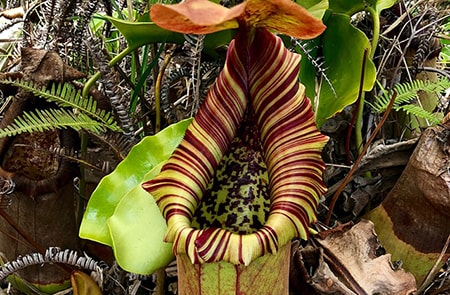
You may have heard of these types of poisonous flowers. These are commonly known as pitcher plants. They're another kind of carnivorous plant and can digest bigger animals like rodents.
Their shape resembles a funnel with a lid on top. They contain strong digestive enzymes in their cavity. Many scientists have taken an interest in them, due to their preying method.
These plants are tall and exist in a different range of colors. They use their leaves to trap the prey once they venture into the funnel-shaped cavity.
They need sunlight, moist soil, and an open place to grow. Additionally, they occur in 80 species in various regions of the world. Pitcher plants are widely found in the southeastern area of North America.
Poisonous Flowers May Look Nice, But...
Nowadays, it's sadly too widespread to grow such flowers outdoors, when you could grow edible berry bushes instead or literally anything else. Though these flowers can add a little brightness to your dull and dreary days, they can be very deadly if they are not appropriately handled.
All of these toxic flowers are beautiful and a fascinating topic to start a conversation with your guests. Apart from that, if you have pets or kids in your house, we recommend that you not keep these plants aronud.
If anyone has touched these flowers without necessary precautions, they must not wait for the symptoms to appear. Instead, they should immediately seek help; it's the best option to consult a doctor if such a situation occurs.
In addition to that, make your purchase after completely understanding how to grow the poisonous flowers of your choice and making sure that you can fulfill its needs, and your own. Please do not have an accidental exposure.



